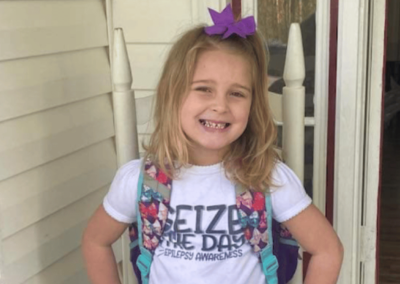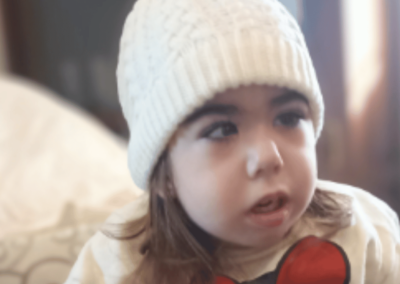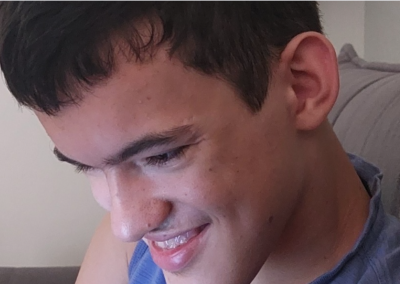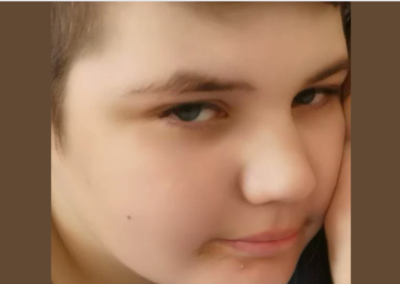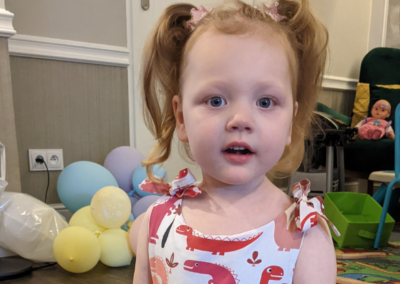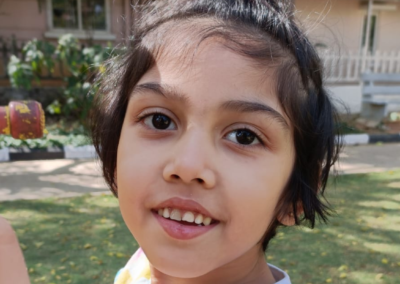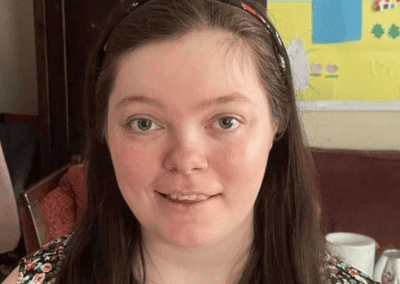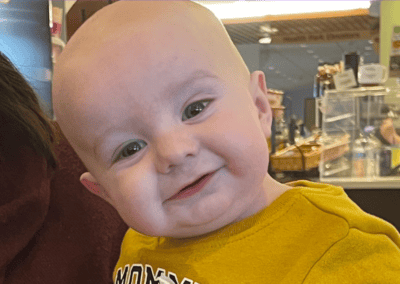
Meet Our Families

Eleanor
Mosaic Deletion GABRA1 & GABRG2
We were a typical family until Eleanor was about 18 months old. At that time I noticed something was atypical in her behaviors and by then she’d already experienced her first seizure. It wasn’t until a few months later that we traveled to Israel and my son first found Eleanor shaking with pale skin and blue lips. She was completely unresponsive.
I’m still haunted by the thought of holding her in my arms thinking that she was dying as my son screamed.
“I love her! I don’t want her to die.” I knew then that our lives were going to be forever changed.
Months were spent trying to diagnose Eleanor. Physicians just did not know, and they told me to wait and see. At this moment I knew that Eleanor needed me more than ever to be her voice. To be a strong advocate. I spent hours on the internet many a late nights, searching for an answer. I ran every test under the sun and I was determined as any mother should be.
I knew that as long as I had a diagnosis regardless if there were any clinical trials or publications available science would be able to find her a cure.
Eleanor’s Mother

Carmen
Mutation in GABRB3
Carmen is a beautiful 3 years old girl. She is loved dearly by her mother Laura, father Javier, as well as the rest of her relatives and all who know her! She lives in Málaga, Spain with the daily battle of a severe and rare form of Epilepsy, called Migrating Partial Seizures Of Infancy. This condition is considered terminal. For Carmen this condition is caused by a gene mutation of her GABRB3 gene, that happened spontaneously (or “randomly”, but not inherited.) When his DNA from her was very first forming. This was not something that was able to be detected on ultrasound or bloodwork while she was in her mother’s womb. Carmen was thought to be perfectly healthy during pregnancy and even after she was born. There were no complications with her birth, she has born a hefty 2,5 kg and checked out in tip top shape! She breast fed normally and was thriving. By 1 month of age her mother noticed she was having “subtle” seizures. But she would soon be having around 100 seizures a day that no anti-seizure medications could put a stop to. Carmen spent most of the first 6 months of her life living in Malaga Children’s Hospital. When it was realized there probably wasn’t more they could try she was finally sent home, miraculously now she is feeling better, maybe now she understands how much love she has with her. More research is needed to alleviate her epilepsy.
Carmen’s Mom

Ilan
Mutation in GABRB3
Ilan, a 9-year-old boy, has successfully achieved the most developmental milestones, except for speech as we have in the family late talkers initially we didn’t take any action until he reached 2.5 years. Since then, we’ve been actively researching ways to help Ilan find his voice. During this journey, we’ve identified other challenges as hyperactivity, lack of focus, anxiety, constipation, comprehension issues and behavioral problems.
Ilan was eventually diagnosed with Autism Spectrum Disorder (ASD) and severe apraxia.
We are still on the lookout for effective ways to support Ilan, and we are particularly hopeful that joining to the GABA A family will make this journey easier for him.
Ilan’s Mom

Paola
Mutation in GABRA5
“Ciao a tutti,
Sono Paola, ho 4 anni e ho una mutazione del gene GABRA5 che mi ha causato una tetraparesi ipotonica aposturale , encefalopatia epilettica farmaco resistente grave ritardo motorio e cognitivo. In Italia sono il primo caso di questa rarissima mutazione e non esiste una cura per me, al momento , per la mia malattia.
La diagnosi precisa è encefalopatia epilettica e di sviluppo con crisi migranti farmacoresistente sintomatica di mutazione del gene GABRA5. Tetraparesi ipotonico-distonica.”
Hello Everyone,
My daughter Paola has a mutation in the GABRA5 gene that has caused apostural hypotonic tetraparesis. This is a drug-resistant epileptic encephalopathy with migrating seizures, severe motor and cognitive retardation. In Italy, this is the first case of this very rare gene mutation.
The precise diagnosis is epileptic and developmental encephalopathy with drug-resistant migrating seizures symptomatic of GABRA5 gene mutation. Hypotonic-dystonic Tetraparesis.
Paola’s Mom

Pilar
Mutation in GABRA1
Pilar is a happy little girl with a loss of function mutation in GABRA1. Due to this mutation, she has epilepsy and intellectual disability. Her seizures started when she was 9 months old and were initially diagnosed as febrile seizures. However, as she grew up, she started having non febrile tonic-clonic seizures and missing development milestones. Currently she has mostly absence crisis and has some autistic features.
Pilar’s Mom

Jillian
Mutation in GABRB3
Jillian began having seizures at around 3 months old. They were very subtle and short. A school nurse recognized what was going on with Jillian and she was immediately transported to the hospital. Jillian was have 10-20 seizure a day. Shortly after she was diagnosed with GABRB3 with gain of function. Jillian is developmentally delayed, nonverbal, and has hypotonia. She is the sweetest 4 year old girl. She receives several therapies PT, OT, Aquatic OT, Speech. Her seizures are uncontrolled and change. Our biggest change at this moment is finding an aid to assist with day to day life. We hope to bring more awareness, join any research to give Jillian the best quality of life possible.
Jillian’s Mom

Charles
Mutation in GABRA2
Charles is a 3 year old little boy who started having infantile spasms around 8 months. From there we found out that he had the rare genetic mutation of GABRA2 gene. He has tried many different medications and surgery to try to help control the seizures so far nothing has worked. He has global developmental delays and works on PT OT and speech multiple times a week. He is nonverbal non ambulatory and He is the sweetest boy around. Typically smiling and laughing and loves to be with people. We hope researchers can help us find what we need to help him control his seizures and progress.
Charles’s Mom

Ivy
Mutation in GABRG2
Meet Ivy! She’s a 4 1/2 year old warrior! When I was 18 weeks pregnant we found out by ultrasound that Ivy has multiple joint contractures and bilateral clubfoot. We did not know the extent of all contractures until she was born.
She was then diagnosed with Arthrogryposis Multiplex Congenita, Bilateral Clubfoot, Bilateral Hip Displasia, Scoliosis and Torticollis. I knew this was going to be quite some journey. In September 2022 her journey shifted. She had her first febrile seizure. Not long after that prolonged absence seizures began.
She now has tonic-clonic ones. As well, we started seeing regression in Ivy and developmental delays. She stopped saying the handful of words she knew and would no longer point to her nose or wave, etc., all leading to the diagnosis of autism. We did genetic testing in March 2023 and the results came back that she has a mutation in GABRG2 that could be the cause of all her challenges.
Despite 4 surgeries so far, countless therapies and all around challenges of her everyday life, she is one happy amazing little girl. She’s so strong, stubborn, loves music, has the funniest faces and sense of humor, very determined and inspires so many people.
She has definitely been proving people wrong since she was born! If it’s challenging, she’s going for it..even if that means figuring it out Ivy’s way. Watching her struggle is not in my future plans! This research means everything, not just for more answers but for better treatments and therapies.
Awareness +Research= a better quality of life.
Ivy’s Mommy

Ava
Mutation in GABRA1
This is our Ava. She is 7 years old and despite her health challenges; she is one of the happiest kids you’ll ever meet. Ava experiences many challenges due to her GABRA1 gene. She is an epileptic with uncontrolled seizures. We have exhausted every treatment we could try and she is still seizing while on medication. She also experiences learning barriers due to autism and developmental delays. Ava struggles with comprehension and the ability to stabilize her emotions and moods. Her brain is unable to filter all the information coming in, causing her to stay in a state of overwhelm. It’s hard for Ava to communicate how this makes her feel but we know it has to be hard because we have bad days. Overall, Ava is a fighter and remains bubbly and optimistic. Ava is beloved by all who know her. Life with Ava may be challenging, but it is nothing short of rewarding. We are so blessed to be able to love and care for her. We are hoping that through research studies we are able to find a better path in life for Ava. We also hope that our story can help other children like her.
Ava’s Mom

Luke
Mutation in GABRA1
In the midst of the 2021 pandemic, our family welcomed Luke, a perfect baby born full-term and healthy. His early days were blissful, but by six months, subtle signs began to emerge, hinting at an underlying challenge. Luke’s eyes appeared slightly off-axis, and he was not meeting developmental milestones typical for his age.
As he approached his first birthday, our concerns intensified. Despite our best efforts, Luke struggled with weight gain, lagging behind in development. This marked the beginning of a relentless quest for answers, leading us through a maze of medical consultations.
The turning point came with genetic testing at Johns Hopkins, revealing a GABRA1-related disorder. This diagnosis left us with more questions than answers, as Luke showed no signs of epilepsy, a common association with this condition. The medical advice we received was patient: only time would reveal the full extent of Luke’s challenges.
Our days became a whirlwind of research, appointments, and therapies, each step a testament to our unwavering commitment to Luke’s well-being. Now, at 2 years and 4 months old, Luke weighs 22 pounds, a hard-won gain of 2 pounds over a year and a half. His world is one of exploration: he crawls with purpose, pulls himself to stand, and finds joy in the simplest activities like pushing a ball or basking in the glow of bright, flashing lights.
Despite the developmental delays – now more pronounced – Luke’s spirit remains unbroken. His laughter and smiles are a balm to our worried hearts. He cherishes moments with his family, including his sister Annabella and our two dogs, finding comfort in the familiar and love that surrounds him.
As we continue this journey, the frequency of doctor appointments may have reduced, but the quest for understanding and support for Luke persists. We share our story not only as a chronicle of our challenges but as an outreach to others navigating similar paths. In the face of the unknown, our family’s story is a testament to resilience, love, and the enduring hope for a brighter future for Luke..
Luke’s Dad

Briana
Mutation in GABRB2
This beautiful girl is Briana and she is 17 years old. She has a smile that brightens everyone’s day! Briana had been a mystery child for 12 years. She was finally diagnosed with a genetic mutation on GABRB2 when she was 12.
She had her first seizure(s) when she was 9 and they have been controlled on medication. Briana started walking when she was 5 years old. Briana is non-verbal, but that doesn’t stop her from getting what she wants!
She is the biggest social butterfly who loves everyone. Briana does PT, OT, Speech, Aqua PT, and Equine Therapy!
Briana’s Mom

Sarah
Mutation in GABRB3
Sarah is 23 and has a diagnosis of LGS and ASD. More recently a GABRB3 variant was identified as the likely cause of her epilepsy. She has developmental/intellectual delays, expressive language difficulties, and generalized drug resistant seizures. As a baby she was on the late end of each developmental milestone and had her first noticed seizure at 1 year old. She was initially treated with her first medication: seizures seemed under control and she progressed, leading her doctor to believe it was something she would outgrow.
At the age of 2.5, Sarah started having seizures again, regressed in many milestones (stopped walking and talking), and we’ve been chasing the seizures ever since. She started on the Ketogenic diet at the age of 3 and is currently on Low Glycemic Index diet. The diet helped in part, which allowed her to regain her lost milestones. She also has a VNS. At her worst Sarah suffered with 80-100 seizures per day. At her best she is having 3-5 seizures per day along with frequent EEG spikes (every 10 seconds). Over the years she has tried 24 different medications in various combinations and participated in three investigational drug trials, while enduring medication side effects, honeymoon periods, injuries, and other setbacks.
We have worked very hard with therapists and the school district to help her thrive and improve her quality of life. Our focus has been to support Sarah in all she can do, and we are amazed at what she has been able to accomplish given the adversity. Sarah truly is a warrior in every sense of the word. But every day is a struggle, and every new treatment option continues to be a “band aid solution”, rather than a focus to address the root cause of her epilepsy.
We are so happy to have found a group of GABAa families and we look forward to making connections and working together to advocate for a much-needed cure.
Sarah’s Mom

Coline
Mutation in GABRA1
After 2 miscarriages and a baby loss during pregnancy, we were so happy to welcome our new addition to the family and named her Coline, Hope. Coline had trouble with eye contact and motor skills development at 6 months old. And that is when the nightmare began! We multiplied clinical exams and therapies. Thanks to intensive physical therapy, she reached some milestones with a huge delay (opening her hand, grabbing toys, grabbing her feet, rolling , eye contact).
She was diagnosed with severe neurodevelopmental troubles and then the exome sequencing revealed a gabra1 gene mutation. Only one amino acid changes on one of the two genes and she will have to be brave and fight for the most common things during her all life.
There is no treatment and you have to be prepared to face a severe intellectual deficiency as well as an inhability to walk or even sit » the neuropediatrician said . As parents, we need to fight as a treatment is possible and she deserves a chance at life!
Now, she has up to 6 therapies a week and she is only 5 . So far, she is not able to sit or crawl. She needs a molded corset seat and a standing frame. She has uncontrolled motions. Her fine motor skills are really limited. She is not able to communicate yet (babbling). It is really hard to know what she is able to understand. She has strabismus and still needs to eat mixed food. Sh ealso has epilepsy. Life with Coline is full of joy but it is like we have had a 7 months old baby forever. It is a big challenge!
She is an amazing, happy little girl. She is always smiling even if she fights every single day to achieve common action. She is so brave and inspiring. We are fully dedicated to give her the hope as we even chose that word as her middle name !
Coline’s Mom

Amelie
Mutation in GABRB1
Amelie was diagnosed with a rare variant in GABRB1.
Because she is the only one(so far) with this variant she is labeled with “unknown significance”. Her neurologist and doctors believe this is the missing diagnosis for Amelie, as she has been a mystery until this finding.
Since infancy, Amelie has had hypotonia, oral dysphasia, fine and gross motor skill delays,and didn’t learn to walk until 3 1/2 years old. Amelie is currently learning how to go up and down stairs and maybe one day jump!
Her MRI found some white matter and was diagnosed with cerebral palsy. It was interesting to find that a lot of GABRB1 one patients have some white matter like Amelie found on MRI scans.
Amelie is also diagnosed with ASD, oral dysphasia, and global development delay, and does have an intellectual disability.
She has yet to speak and has a hard time focusing. Her fine motor skills are still developing, but she is making progress, and can even do a couple of ASL signs. She also still has her startle reflex.
Amelie has had 2 EEGs, both normal so far. She is a determined little girl, who loves to try new things and loves so many activities. She never gives up, and she is learning and growing at her own pace.
Amelie’s Mom

Scarlett
Mutation in GABRA1
At 3 months the old she had her first seizure. This took us down a very long road of tests, finally resulting in genetic testing. We found that she has a de novo GABRA1 gene mutation with gain of function. She was on at least 5 medications before finding a good combo; Vimpat, Topiramate and Epidialex (CBD). Once the seizures were under control, her dystonia increased substantially, which we are still dealing with.
She’s currently 22 months and we are still working on sitting independently, she does not reach for anything, or make much eye contact. Lots to work on but we still have progress.
Scarlet’s Mom

Link
Mutation in GABRG2
My son Link is going to be three on March 1st. When he was a little over a year old he was playing and pushing a garbage can and he stopped and was frozen. He was not there.
He could hold and drink his sippy cup but when I called him or waved my hand in front of his face nothing happened. We had him taken to the hospital and they said he had an absent seizure which could have been a one and done thing. It is normal in children.
We were sent to a neurologist because his pediatrician thought he had a big head. We didn’t have a good experience with this neurologist. My son had another seizure and we spoke with the wonderful ER doctor who suggested we see this other neurologist who had just moved to our area from Atlanta.
We had our first appointment with her and she automatically wanted to run a genetic epilepsy panel because she wanted to find out the cause. Once that came back and we found out he has GABRG2. She wanted to test my husband and I to see if we had the same thing. My husband came back positive for it. He had seizures as a baby and then never found out why.
Over the course of time my son’s seizures have changed from absent to shaking and stiffness. He does make a yelling noise when they happen. He was put on Keppra when he first had another seizure after the first one. We never know when the seizures are going to come on. They just happen. The variant that both my son and husband has is very rare and it is being studied by Sebastian Ortiz in Denmark to learn more. My son is the first person they have seen with this variant.
Every time he has a seizure they up the keppra which I feel makes the seizures worse. He was put on another medication to help stop seizures.
My family along with doctors are learning about this variant as we go since this is so rare. The neurologist has sent us to another neurologist for a second opinion in Atlanta since she worked there. We are hoping to learn more and get some relief for this. It has been a struggle. It is not easy watching your child go through medical issues. Every time he has a seizure we give him his emergency meds and he goes to the hospital. Some are worse then others. He is a fun loving little boy.
Link’s Mom Muryah
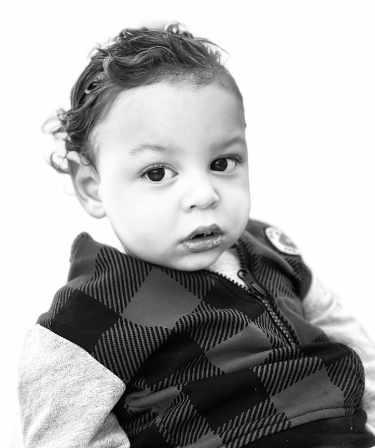
Boss
Mutation in GABRB3
Boss, the youngest of four siblings, started life as a healthy and vibrant baby. Unfortunately, at the age of 5 months, he faced a sudden and challenging turn when he experienced his first seizure. Swiftly placed on five different medications, Boss encountered a difficult journey marked by regression. Despite the setbacks, Boss exhibits remarkable strength and resilience.
Engaging in therapy five days a week, he’s working diligently to relearn essential skills like sitting, rolling, and feeding. Boss, once a joyous and cheerful baby, hasn’t smiled in a year due to the ongoing battle with daily seizures. However, his unwavering determination, coupled with improvements after discontinuing some medications, instills hope that one day, his infectious smile will light up his face again. The journey continues, fueled by the commitment to witness Boss’s radiant smile once more.
Boss’s Mom

Laura
Mutation in GABA-A Variant
“La historia de Laura comienza hace dos años y medio,cuando mamá tras un embarazo estupendo le llegó la hora de traerte al mundo desde ese día luchas contra una encefalopatía epiléptica del desarrollo provocada por una mutación genética,la cual te provocaba más de 40,50 crisis diarias una grandísima hipotonía y una gran cantidad de ingresos hospitalarios a día de hoy seguimos luchando y creemos que la cura y mejora de tu calidad de vida cada día está mas cerca.Tu GUERRERA eres el motor de nuestras vidas”
Laura’s story begins two and a half years ago, when after a wonderful pregnancy, mum brought you into the world. Since that day, you have been fighting against developmental epileptic encephalopathy caused by a genetic mutation, which caused you more than 40,50 daily seizures, a huge hypotonia and a large number of hospital admissions. Today we continue to fight and we believe that the cure and improvement of your quality of life is closer every day. You are a WARRIOR and the engine of our lives.
Laura´s Mom

Adele
Mutation in GABRA1
“Adele é nata il 23 aprile 2005. Nella prima infanzia ha presentato ritardo nella capacità di svolgere autonomamente le normali funzioni corporee, ma ha iniziato regolarmente a parlare. Non ha presentato difficoltà motorie. A 9 anni, quando già si sono rivelati problemi di deficit dell’attenzione e lieve ritardo dell’apprendimento, ha avuto una forte crisi epilettica con crisi respiratoria e coma, che ha richiesto ricovero d’urgenza. A seguito di questa manifestazione sono state avviate indagini che, successivamente, presso l’ospedale Meyer di Firenze, hanno portato alla diagnosi di mutazione Gabra-1. Negli anni successivi il ritardo si è manifestato sempre più significativo, comportando difficoltà scolastiche e cognitive, associate a manifestazioni di occasionale aggressività, depressione, inedia, atteggiamenti oppositivi e non collaborativi. Per questo ha ottenuto il sostegno scolastico. Nelle indagini del Meyer é risultata una iper-alaninemia plasmatica non spiegata. L’analisi Array-CGH e il sequenziamento del DNA mitocondriale sono risultati negativi. É stata effettuata biopsia muscolare che ha evidenziato un quadro istopatologico di minima variabilità.
Allo stato attuale dei fatti, Adele si presenta insicura e spesso timorosa, oppositiva e tendenzialmente molto pigra. Tende a non collaborare nella vita domestica e sociale, ha avuto un regresso nella capacità di leggere e scrivere, presenta occasionali manifestazioni di aggressività verso oggetti e persone e ha bisogno di assistenza continua pur conservando una certa autonomia nelle funzioni quotidiane, come vestirsi, mangiare e bere e altri piccoli compiti domestici.”
Adele was born on 23 April 2005. In early childhood she had a delay in the ability to independently carry out normal bodily functions, but she began to speak regularly. She did not present any motor difficulties. At 9 years old, when problems with attention deficit and slight learning delays were already revealed, she had a severe epileptic seizure with respiratory crisis and coma, which required emergency hospitalization. Following this event, investigations were started which subsequently led to the diagnosis of the Gabra-1 mutation at the Meyer hospital in Florence. In the following years the delay became increasingly significant, leading to scholastic and cognitive difficulties, associated with manifestations of occasional aggression, depression, starvation, oppositional and non-collaborative attitudes. For this she obtained school support. In Meyer’s investigations it turned out to be one unexplained plasma hyperalaninemia. Array-CGH analysis and mitochondrial DNA sequencing were negative. A muscle biopsy was carried out which highlighted a histopathological picture of minimal variability.
In the current situation, Adele appears insecure and often fearful, oppositional, and generally very lazy. She tends not to collaborate in domestic and social life, has had a regression in his ability to read and write, presents occasional manifestations of aggression towards objects and people and needs continuous assistance while maintaining a certain autonomy in daily functions, such as dressing, eating and drinking and other small domestic tasks.
Adele´s Mum

Pascale
Mutation in GABRA1
Our 4 year old daughter currently has the only known variant on GABRA1. She has epilepsy, incredibly limited mobility, non-verbal with very little-to-no understanding, can’t feed herself, double incontinent, Global Development Delay, intellectual disability, 100% dependent upon others for everything.
Pascale´s Mom

Beltrán
Mutation in GABRA1
“Mi hijo tiene 9 años, es el pequño de 3 hermanos. Nació bien y a los 3 meses tuvo su primera crisis de epilepsia. A partir de ahi comenzó su epilepsia y una busqueda de diferentes medicamentos para controlarla. También nos dimos cuenta que su desarrollo no iba bien y comenzo en terapias. El tiene un grado grave de discapacidad, no tiene lenguaje, camina con ayuda, hipotonia, en definitiva, un retraso global del desarrollo.
Al año le apareció el primer episodio distonia causada (despues de mucho investigar) por el depakine. Su cuerpo adopta una postura anormal y solo se le pasa si duerme. Le da casi a diario.
De crisis ests bien con la combinacion actual: depakine, noiafren y diacomit. Estuvimos un año sin depakine para que no tuviera distonia pero tenia muchas crisis atonicas (perdids del tono muscular). Intentamos buscar una laternativa al depakine, como dieta cetogenica, canabidiol, fycompa,…y no funcionó. Decidimos volver al depakine aunque tuviera la distonia (preferible a las crisis). Actualmente estamos bajando de nuevo depakine e introduciendo lamictal.
Asiste a un colegio de educacion especial, es un niño muy alegre!
Gracias!!!”
Beltrán is the youngest of 3 brothers, he was born almost 10 years ago and everything was fine until the third month, when the epileptic seizures began. From there, we have come a long way looking for the right combination of medications to combat the refractory epilepsy and episodes of dystonia that he suffers from. In turn, he was diagnosed with global developmental delay and at 8 months we began his therapies: physiotherapy, psychopedagogy, equine therapy and hydrotherapy. The diagnosis came at 19 months, epileptic encephalopathy due to NOVO mutation in the GABRA1 gene. Beltrán, he doesn’t speak, we don’t have a system yet to communicate, but we understand just by looking at him. Cognitively he is very affected. He walks with help and at home he is able to take a few steps alone! He attends a special education school and is very happy.
He is an immensely happy child, he enjoys being with his family and us being by his side.
Beltrán´s Mom

Tao
Mutation in GABRA2
“Bonjour, notre histoire commence le 10 septembre 2021 à la naissance de notre fils Tao à l’âge de ces deux mois fait sa première crise épileptique sous forme d’arrêt respiratoire, s’en est suivi plusieurs longs mois d’hospitalisation pour essayer de comprendre ce qui arrivait à notre fils.
Tao faisait 15 à 20 crises par jour et par nuit en étant toujours en apnée respiratoire. Nous avons remarqué par la suite qu’il avait une très grande hypotonie , un retard de développement moteur et Cognitif avec une épilepsie sévère et pharmacorésistantes.
Tao a aujourd’hui 2ans, il ne parle pas, ne marche pas, il est très présent au niveau du regard et c’est un petit garçon très curieux qui aime les gens, très souriant.
En France il n’y aurait que six cas recensés avec aucun recul sur la mutation du gène Gabra2.
Malgré ces quatre anti épileptiques Tao fait quotidiennement des crises épileptiques (spasmes).
Depuis sa naissance Tao a fait beaucoup de petits progrès, il sait maintenant tenir sa tête, attraper un objet qu’on lui tend et tenir quelques secondes assis tout seul.
Nous espérons de tout notre cœur que parmi tous ces témoignages et rassemblement d’enfants qui sont porteurs de cette mutation génétique nous arriverons un jour à trouver les traitements nécessaires pour apaiser nos enfants.”
Hello, our story begins on September 10, 2021 with the birth of our son Tao at the age of two months had his first epileptic attack in the form of respiratory arrest, followed by several long months of hospitalization to try to understand what was happening to our son.
Tao had 15 to 20 seizures per day and night while always in respiratory apnea. We subsequently noticed that he had very severe hypotonia, a delay in motor and cognitive development with severe and drug-resistant epilepsy.
Tao is now 2 years old, he doesn’t talk, he doesn’t walk, he is very present in his eyes and he is a very curious little boy who likes people, very smiling.
In France there are only six cases recorded with no hindsight on the GABRA2 gene mutation.
Despite these four anti-epileptic drugs, Tao has epileptic seizures (spasms) daily.
Since his birth Tao has made a lot of small progress, he now knows how to hold his head, grab an object handed to him and sit for a few seconds on his own.
We hope with all our heart that among all these testimonies and gatherings of children who carry this genetic mutation we will one day be able to find the necessary treatments to soothe our children.
Tao’s Family
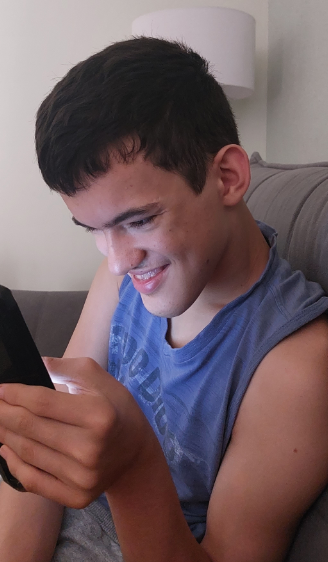
Felipe
Mutation in GABRB2
“Felipe hoje com 20 anos , apos inumeros exames e consultas em especialistas foi diagnosticado com mutacao GENE GABRB2 apenas aos 12 anos com o exame Exoma, somos brasileiros e atualmente só temos notícia de seu irmão mais novo (parte de pai) com a mesma mutação, eles são mais raros por se tratarem de 2 irmãos com a mesma mutação.
Felipe nasceu bem porém percebemos que era uma criança muito nervosa, chorava muito, aos 5 meses ainda nao tinha controle do pescoco e iniciamos fisioterapia, ja era um alerta para seu atraso motor. Sentou sem apoio com 1 ano e andou aos 7 anos. Não verbal, com retardo intelectual severo, é bem agitado. É um mocinho muito feliz, sorridente, muito amado.”
Felipe is now 20 years old, after numerous exams and consultations with specialists he was diagnosed with the GABRB2 GENE mutation just at the age of 12 with the Exoma exam, we are Brazilian and currently we only have news of his younger brother (his father’s side) with the same mutation, they are rarer because they are 2 brothers with the same mutation.
Felipe was born well, but we realized that he was a very nervous child, he cried a lot, at 5 months he still had no control over his neck and we started physiotherapy, which was already a warning about his motor delay. He sat without support at 1 year old and walked at 7 years old. Non-verbal, with severe intellectual retardation, he is very agitated. He’s a very happy, smiling, much-loved little guy.
Felipe’s Mom
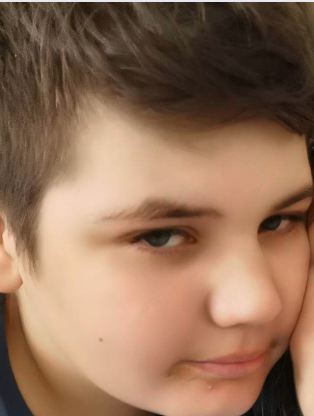
Adas
Mutation in GABRA1
“Adaś urodził się w 2009 r. W wieku 13 miesięcy pojawiły się pierwsze ataki przy infekcji z temperaturą. Od chwili wystąpienia napadów zmagamy się z tą ciężką chorobą, która znacznie spowalniła jego rozwój psychoruchowy. Ma zaburzenia zachowania, opóźniony rozwój mowy, adhd. Przejawia liczne zachowania impulsywne, agresywne i buntownicze, zaburzenia integracji sensorycznej . Jest dzieckiem nadruchliwym, ciężko się z nim współpracuje, ma trudności w rozumieniu poleceń, często bojaźliwy i ogólnie leniwy.
Ciężki do współpracy w życiu domowym, społecznym, szkolnym. Okazjonalnie przejawia agresję wobec przedmiotów i ludzi. Potrzebuje pomocy w codziennych czynnościach. Długo szukaliśmy diagnozy., gdy miał 13lat sekwencjonowanie eksomu potwierdziło mutację Gabra1-zespół Dravet.”
Adaś was born in 2009. At the age of 13 months, the first attacks of infection with temperature appeared. Since the onset of the seizures, we have been struggling with this serious disease, which has significantly slowed down his psychomotor development. He has behavioral disorders, delayed speech development, ADHD. Manifests numerous impulsive, aggressive and rebellious behaviors, sensory integration disorders. He is a hyperactive child, difficult to work with, has difficulty understanding instructions, is often timid and generally lazy. Difficult to cooperate in home, social and school life. Occasionally shows aggression towards objects and people. I need help with everyday activities. We were looking for a diagnosis for a long time. When he was 13, exome sequencing confirmed the Gabra1 mutation – Dravet syndrome.
Adas’s Mom

Dain
Mutation in GABRA1
Meet Dain. He is now 11 years old. Like all the other kids here, his journey and experiences are so unique. He appeared as a typical baby but started showing signs of not interacting with the world around him in a typical fashion around the age of 9 months. The journey that he and our family has gone on since then has been one of many ups and downs and usually a lot more questions than answers. What we have discovered is that Dain has a gain-of-funciton mutatoin in his GABRA1 gene, but rather than stopping there we continued to push for further diagnosis and testing and discovered that Dain has other genetic issues – some common and some not; but taken all together contribute to the many challenges Dain has.
Dain experiences seizures, developmental delays, cycle vomitting, movement disorders and requires assistance with all the normal day to day activities. We have learned to communicate with him through eye gaze. As his parents, we never stop advocating for him; constantly pushing our medical system and his doctors to think outside the box and to not just accept that there is nothing that can be done for him.
Dain´s Mom

Julia
Mutation in GABRB2
Julia was born on November 29, 2017 in England. Julia was classified as a sleeping baby from the beginning and did not want to eat. After several hours of unsuccessful attempts to put her to the breast, I decided to give her a bottle, which she vomited through her nose. This scared me terribly and I started observing her very closely. And I noticed that your hand was shaking and you seemed to want to open your eyes. After a few episodes, I asked the midwife if it was normal, she deserved to be recorded and so I did. After showing this, Julia was immediately placed in intensive care, initially for observation, where she underwent an EEG test which showed burst suppression, then she was put into a medically induced coma and given phenobarbital midazolate. I had a puncture done, a transfontanelle ultrasound and an MRI, everything came back normal. After waking up, she continued her daily activities but still did not wake up. In this hospital, they performed a basic genetic test on us, which also came back negative. In the meantime, they took us to another hospital where there was a neurology department and there, if I remember correctly, ACTH steroids were introduced, as well as numerous medications. Unfortunately, nothing worked and we tried the ketogenic diet, which we followed for over a year with no success. We find her gene mutation (GABRB2 c.850A>C; p.(Thr284Pro) ) through 100000 genomes project. Julia still has onset seizures. She not rich any milestones but we never stop hoping that one day she will be seizures free.
Julia´s Mom

Agata
Mutation in GABRB2
Agata was born in 2018 as a healthy child, at the 8th month of life the first two absentee and apneic seizures appeared, followed by dozens of myoclonic seizures a day. We went to hospital, where pharmacological treatment was initiated. Due to the temperature and flashing lights, my daughter had a large clonic-tonic seizure, which was difficult to control. Before her 2nd birthday, she started a ketogenic diet, which greatly helped our daughter’s development. Shortly afterwards, we received a diagnosis – a mutation in the GABRB2 gene. Currently, Agatka is a smiling 6-year-old girl, she can walk – but only to where she feels like. Myoclonic seizures remain, but it is mainly caused by light, she has to use her blue Zeiss glasses outdoors and in very bright rooms. We don’t go outside much in the summer. Agata says simple words: mom, dad, I want it, eye. She loves singing and instruments and the company of children and adults. We hope that in the future there will be a medicine that will control the epileptic seizures and thus help her discover the world better.
Agata´s Mom

Isla
Mutation in GABRA1
My daughter Isla has a GABRA1 gene mutation. She had her first seizure at 14months. Isla has hypotonia, and a developmental delay. Despite these limitations Isla is a remarkable little lady. She has recently started walking and has several words now. She is very bright, happy and has such resilience and enthusiasm for life. I’m so proud of how she has overcome the challenges life throws at her.
She is on regular seizure medication and her seizures are relatively controlled. Unfortunately they have not stopped entirely but are better than before. I’m hoping by sharing our story it will help others to share theirs. Most importantly help raise awareness and find support and answers for this rare genetic disorder.
Isla´s Mom

Dhwani
Mutation in GABRA1 : LoF
5yr old Dhwani was diagnosed with Gabra1 loss of function in early 2022. It began with developmental delays from her 6th month, and she experienced her first seizure episode at 13 months of age. Routine tests, such as EEG and MRI were conducted, and she was started on medications. However, her seizure pattern varied each time, and she often experienced significant regression in achieved milestones. Despite the addition of multiple medications, her seizures remained uncontrolled. Due to refractory epileptic symptoms, she was introduced to a ketogenic diet alongside anti-epileptic drugs. Currently, her seizures have been under control for the past 1.5 years. Nonetheless, she continues to grapple with other symptoms associated with Gabra1, including weak muscle tone, frequent injuries, slow motor and speech development, as well as immunity and gut-related issues.
We are positive and excited that this group is a ray of hope for Dhwani and us!
Dhwani´s Mom

Raina
Mutation in GABRB3
Our beautiful sweet Raina! She loves cuddles, massage, movement, vocalizing, bath time and being outdoors. She is a true inspiration and warrior in every way.
Raina was diagnosed with a very rare and severe form of epilepsy, called Early Infantile Epileptic Encephalopathy (EIEE). She started having seizures when she was very little, sometime between 2-3 months of age. In the beginning, when we first learned of her epilepsy, we spent many difficult weeks in hospital, trialling all sorts of medications, and she was having upwards of 40-50 seizures per day. We later found out that she has a genetic mutation in the GABRB3 gene with gain of function, making her seizures drug-resistant and challenging to control. She is now 2 years young and still experiences daily seizures (although thankfully far fewer), despite several medications and a strict real food blended ketogenic diet. Raina has severe hypotonia, which causes difficulties with feeding, among many other things, and receives all her nutrition via G-Tube. She has global developmental delay, movement disorders and cortical visual impairment (CVI). We have ongoing therapy appointments for PT, OT, speech and vision. The days are very full in caring for her exceptional needs. Our journey has been extremely challenging, but Raina is such a gift, and we’re in awe of her strength and resilience!
Our biggest challenges, other than controlling seizures, are managing constipation and preventing episodes of neuro irritability, which we call bRainstorms. For many months, she had a lot of trouble managing her secretions, but after undergoing a procedure called salivary duct ligation, she now has reduced saliva production – and we’re so grateful that it has significantly improved her quality of life. Despite all the challenges, we remain very hopeful, advocating for research and new treatments to help Raina and, ultimately, to find a cure!
Raina´s Mom

Hugo
Mutation in GABRG2
This is Hugo, the little brother in our family. He loves the sound of whistling, rattles and his brother’s voice. He also likes disco lights.
Hugo was born in August 2021. It was understood at birth that something was not right. He was small and very weak. He got a feeding tube and have never been able to eat. He had his first seizure at 2 months. When he was four months we found out that he has a deviation in GABRG2.
He is still very weak (hypotonia) and can´t hold his head. The hypotonia makes him having trouble with handling mucus. He needs constant supervision with the risk of pulmonary aspiration. When he gets a cold/infection it´s a really tough struggle and he needs breathing aid. His vision is limited. He has several seizures daily.
Hugo´s mom and dad.

Presley
Mutation in GABRB3
Presley started having seizures at 8 months old. Before this she was healthy and hitting her milestones fairly well. She had a series of 3 seizures in one day. After this she was put on Keppra. Several months later she had another seizure and then more to follow. Total she has experienced 17 seizures and is currently 2 and a half years old. She has a speech delay as well. We hope to find out more to help her. We want these seizures to stop and for her to grow up to be a healthy happy girl.
Presley´s mom

Timo
Mutation in GABRA1
“Timo bekam im Alter von 4 Monaten Probleme mit dem Augenkontakt und der Entwicklung motorischer Fähigkeiten. Es folgten viele Untersuchungen. Timo wurde als Blind eingestuft. Die Ärzte waren ratlos, vermuteten einen schicksalhaften Sauerstoffmangel und sagten sie können nichts tun und wir sollten ihn im Rahmen seiner Möglichkeiten fördern. Mit 7 Jahren begann die Epilepsie. Eine Anfallsfreiheit konnten wir bis heute nicht erreichen. Trotz etlicher Therapien lernte er nie frei sitzen, laufen, sprechen. Nach der jahrelangen Ungewissheit ergab 2021 die Trio-Exomsequenzierung eine Mutation im Gabra1 Gen. Wir sind froh endlich eine Erklärung für seine schwere Mehrfachbehinderung zu haben. Heute ist Timo 22 und wir hoffen auf eine Behandlung um seine Beschwerden zu lindern und seine Lebensqualität zu verbessern.”
Timo started having problems with eye contact and developing motor skills when he was 4 months old. Many investigations followed. Timo was classified as blind. The doctors were at a loss, suspected a fateful lack of oxygen and said there was nothing they could do and that we should support him as much as possible. The epilepsy began at the age of 7. To date we have not been able to achieve freedom from seizures. Despite numerous therapies, he never learned to sit, walk or speak freely. After years of uncertainty, trio exome sequencing in 2021 revealed a mutation in the Gabra1 gene. We are happy to finally have an explanation for his severe multiple disabilities. Today Timo is 22 and we are hoping for treatment to alleviate his symptoms and improve his quality of life.
Timo’s dad

Aleta, Joe, Anessa, Alvina
Mutation in GABRG2
Joe & Aleta have the GABRG2, they are now adults. Early years was very challenging for both. They are my warriors. Joe at 2 1/2 years old went into respiratory arrest, after a prolonged seizure of 90mins. due to the mutation being reactive to rectal diazepam. He has complex needs, including autism, severe anxiety, ADHD, severe learning disability, hypotonia buttoning feet & behaviour that challenges. Aleta also has the same complex needs as her brother, she doesn’t have ADHD. In 2015 Aleta developed Toxic Epidermal Necrolysis to Phenytonin due to he regular tonic clonic seizures. It meant that Aleta has medical trauma, she is arouamatic to medication, which in turn puts all her siblings and myself at risk of lifethreatening allergy. She has had to work very hard to gain back her daily living skills. Joe & Aleta have a dravet syndrome symptomology. We are a family with epilepsy, 6 of us in all, apart from my husband. 4 of us have GABRG2 . What I most want for Joe & Aleta is understanding, of their complex needs, to see them develop living skills & to see them happy.
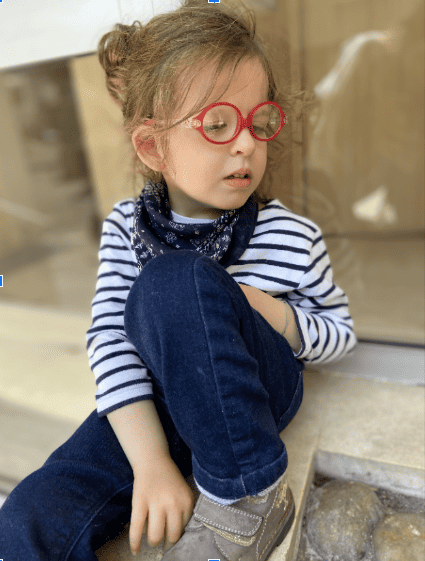
Nina
Mutation in GABRA3
Bonjour, je suis la maman d’une petite fille de 5 ans, Nina, atteinte d’une mutation génétique GABRA3. Elle présente un retard global de développement. Elle commence à marcher avec de l’aide. Elle ne verbalise pas. Elle est très souriante et affectueuse. Les nuits peuvent être agitées.
Je découvre aujourd’hui votre communauté et j’en suis très heureuse.
Nina’s Maman
Hello, I am the mother of a 5-year-old girl, Nina, who has a GABRA3 genetic mutation. She has an overal developmental delay. She begins to walk with help. She doesn’t verbalize. She is very smiley and affectionate. Nights can be restless.
I discovered your community today and I am very happy about it.
Nina’s Mom
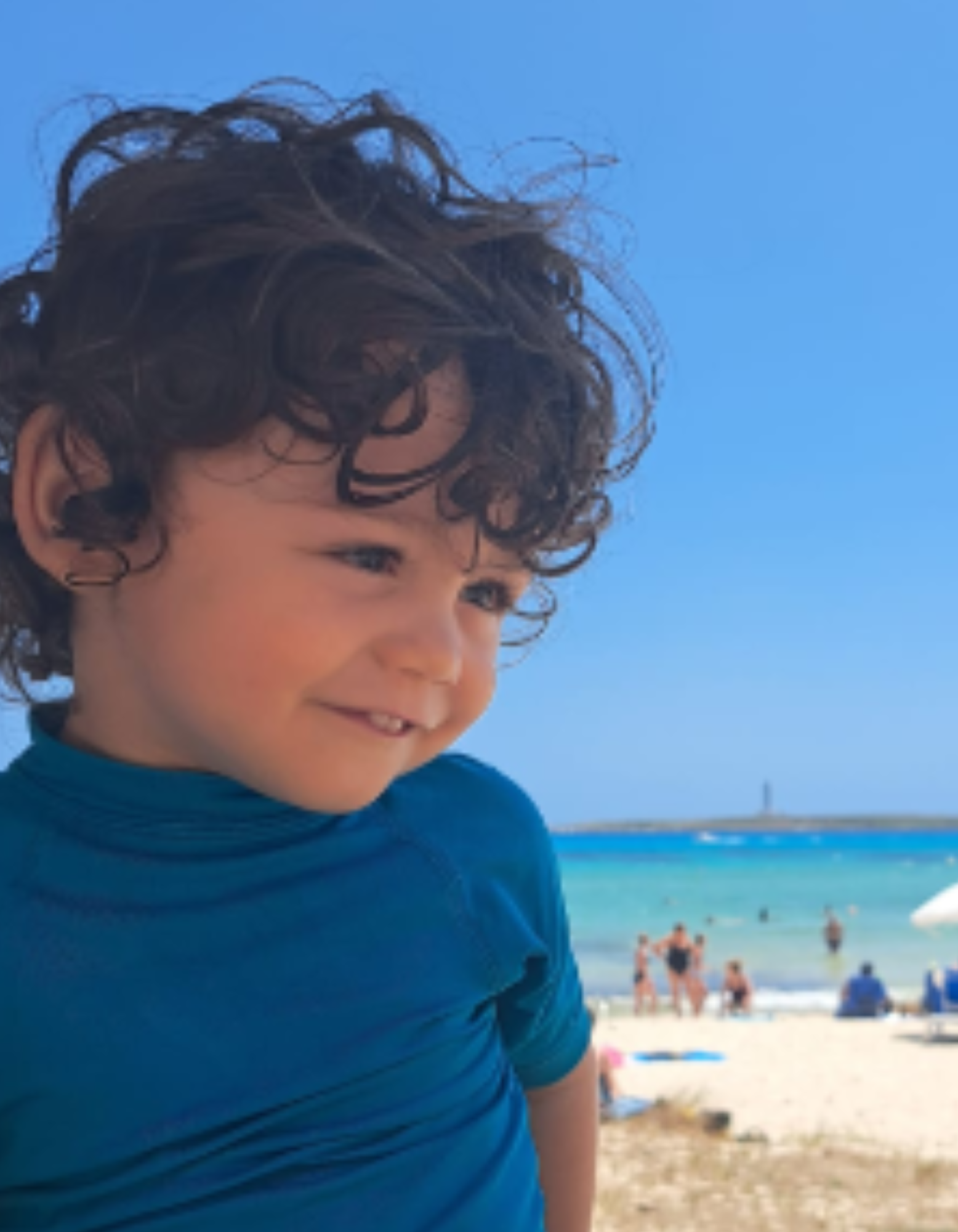
Javier
Mutation
“Javier fue un bebé nervioso en sus primeros meses, que se agitaba mucho, pero las alertas saltaron a los 7-8 meses, debido al retraso que llevaba al sentarse. Comenzó a ir a atención temprana y a una terapeuta ocupacional privada, pero el retraso global se fue haciendo cada vez más acusado, sin completar los hitos relativos a su edad. En la actualidad tiene casi tres años y no anda por sí solo ni está desarrollando el juego simbólico ni el lenguaje. Tuvimos un diagnóstico gracias a un análisis genético cuando tenía 2 años y medio. Comenzó una dieta cetogénica que ha dado buen resultado en cuanto el niño se encuentra más centrado y atento. Estamos a la espera de realizar un electroencefalograma continuo para averiguar si tiene ataques epilépticos que pasen desapercibidos y si los canales gabaérgicos son de pérdida o de ganancia de función y así poder implementar una medicación adecuada para él.”
Javier was a nervous baby in his first months, who agitated a lot, but the alerts jumped at 7-8 months, due to the delay in sitting up. He began to go to early care and a private occupational therapist, but the overall delay became more and more pronounced, without completing the milestones related to his age. He is currently almost three years old and is not walking on his own nor is he developing symbolic play or language. We had a diagnosis thanks to a genetic analysis when I was 2 and a half years old. He started a ketogenic diet that has had good results in that the child is more focused and attentive. We are waiting to perform a continuous electroencephalogram to find out if he has epileptic seizures that go unnoticed and if the GABAergic channels are loss or gain of function and thus be able to implement appropriate medication for him.
Javier’s Family

Lena
Mutation in GABRA1
“Córka Lena, lat 13 w wieku około 1,5 zdiagnozowana mutacja SCN1A, w wieku około 10 lat zdiagnozowana mutacja GABRA1. Córka ma opóźnienie rozwojowe, niepełnosprawność w stopniu umiarkowanym. Napady w tej chwili występują rzadko. Na stałe z leków przyjmuje Cezarius. Jest dzieckiem bardzo pogodnym i dobrze rozwiniętym społecznie.”
Daughter Lena, 13 years old, diagnosed with SCN1A mutation at the age of about 1.5, GABRA1 mutation diagnosed at the age of about 10. My daughter has developmental delay and moderate disability. Seizures are rare at this time. She takes medications permanently. Overall, she is a very cheerful and socially well-developed child.
Lena’s Mom

Molly
Mutation in GABRA2
Molly was born with severe low muscle tone and started having seizures at 5 months old. She then started having infantile spasms at 9 months old. She also has dystonia, developmental delay and cortical vision impairment. She has had two major regressions coinciding with infantile spasms. At 1 year old we were told she has a de novo GABRA2 mutation. She is the same boy known case with her specific variant. With so few cases worldwide there is very little information. We are hopeful for more research on this rare genetic mutation.
Molly’s Mom

Hudson
Mutation in GABRB3
My son, Hudson, started showing concerning signs in January. He would have these episodes of his eyes rolling back in his head and my guy told me to take him in to the ER when one night it lasted for over five minutes and he was not responding to any stimuli. That night he was transported to the children’s hospital where they said he was having seizures. They did blood work, a spinal tap, a CT scan and EEG. They admitted us and kept him on EEG. They diagnosed him with epilepsy but his EEG wasn’t very straight forward with how he was presenting clinically. They discharged us with being started on Keppra and Steriods. Within a day we were back at the hospital, admitted again. He was having so many seizures. They did an MRI as well. We had the genetic testing done at the neurologist appointment we had soon after. One that was not that in depth and one that looked deeper into his genes. During the waiting period, he was still struggling so we added phenobarbital. We saw great improvement in his development skills returning such as his speech and ability to roll over and his core strength. We got back the first test showing the mutation on GABRB3 and ZMYND11. His neurologist was most concerned with the GABRB3 one. He was doing alright up until about 3-4 weeks ago when he started not being able to tolerate his medication orally and would throw it up immediately. This set him back developmentally a lot. Over a week and a half he started to become floppy and couldn’t keep his head up. He slept most the day. We saw his pediatrician who sent us to ER to be admitted. We met with the doctors who placed a NG tube to allow him to get his medication. He regained some of his function quickly but he would not keep the NG tube in. We decided to have a Gtube placed to manage his medication better and it’s been about 2 weeks and it is going well. He is still having some seizure activity daily, but able to keep meds down. We are going to be starting physical therapy soon, as well as the keto diet. We meet with a genetic counselor soon. We also have an appointment in Seattle in May with a pediatric neurologist.
Hudson’s Mom

Antoś
Mutation in GABRB1
“Jestem mamą Antosia u synka w wieku 5 miesięcy zdjagnozowano zespół West w wieku 8 miesiecy przyszła kolejna diagnoza mutacja Genu GABRB1. Antoś od początku bardzo płakał w wieku trzech miesięcy przestał się rozwijać prawidłowo i wtedy pojawiły się pierwsze objawy padaczki . Na dzień dzisiejszy ma skończone 19 miesięcy Antoś sam nie siedzi , nie chodzi i nie mówi.”
I am the mother of Antoś, my son was diagnosed with West syndrome at the age of 5 months, and at the age of 8 months there was another diagnosis of GABRB1 gene mutation. From the beginning, Antoś cried a lot, at the age of three months he stopped developing properly and then the first symptoms of epilepsy appeared. As of today, he is 19 months old. Antoś cannot sit, walk or talk on his own.
Antoś Mom

Miriam
Mutation in GABRR2
“Witam Wszystkich. Mam córkę Miriam ,która obecnie ma 7 lat. W 2023 roku podczas badań genetycznych u mojej córki wyszedl gen GABRR2.
Prócz tego genu ma jeszcze inne geny.
Jest wesoła rezolutną 7latka,ale od 3 miesiąca życia, zmaga sie z wieloma problemami zdrowotnymi.
Cytomegalia,krwiak mostkowo-obojczykowo-suykowy.W wieku 11miesiaca życia przeszka sepsę i tu zaczęła sie basza przygoda,że szpitalami, wyszły podejrzenia,zaburzeń odporności.
Jesteśmy pod opieką centrum Zdrowia Dziecka w Warszawie oddzialu immunologii.
Hippogammaglobulinemia, zaburzenia układu dopelniaczaCH50. Częste infekcje,zapalenia oskrzeli i płuc, bóle piszczeli, głowy.
Refluks żołądkowo-przelykowy, podejrzenie astmy,nietolerancja mleka i Białka jaja kurzego.
Przy infekcjach kiedy Miriam śpi,ms wzdrygamia całego ciała, są one w tedy nasilone,po infekcjach zdarzają die kilka razy w tygodniu.
W badaniach genetycznych, ma eirle mutacji,związanych z krzepnieciem krwi, podejrzenie Ehlersa-Danlosa,gen C7,związany z zsbueniami odporności.
Nadal nie mamy pełnej diagnozy,odsyłani jesteśmy od lekarza do lekarza.
I każdy mowi co innego.
Mam nadzieję, że natrafimy w końcu na takiego lekarza, który w pełni sie zajmie,potwierdzi lub wykluczy co córce jest.“
Hello everyone. I have a daughter, Miriam, who is currently 7 years old. In 2023, during genetic testing, my daughter was found to have the GABBR2 gene. In addition to this gene, it has other genes. She is a cheerful and determined 7-year-old, but since she was 3 months old, she has been struggling with many health problems.
Cytomegaly, sternocleidomastoid hematoma. At the age of 11 months, I suffered from sepsis and this is where my adventure began, when the hospitals suspected an immune disorder. We are under the care of the Children’s Health Center in Warsaw, immunology department.
Hypogammaglobulinemia, CH50 complement system disorders. Frequent infections, bronchitis and pneumonia, shin pain, headaches. Gastroesophageal reflux, suspected asthma, milk and egg white intolerance. During infections, when Miriam is sleeping, the whole body shivers, so they are more severe, after infections they happen several times a week.
In genetic tests, he has several mutations related to blood clotting, suspected Ehlers-Danlos, C7 gene, related to immunodeficiencies. We still don’t have a full diagnosis, we are referred from doctor to doctor. And everyone says something different. I hope that we will finally find a doctor who will fully take care of us and confirm or rule out what is wrong with our daughter.
Miriam’s Mom

Syzmon
Mutation in GABRB1
“Szymon urodził się w styczniu 2013 roku. Na początku wszystko było ok, aż do czasu gdy w 4 miesiącu życia został zaszczepiony. Z dnia na dzień przestał się ruszać i reagować na otoczenie. Po wielu rehabilitacjach i terapiach w wieku dwóch lat nauczył się chodzić. Nigdy jednak nie zaczął mówić, rozumieć otaczającego go świata. Nie rozumie, że pewne rzeczy są niejadalne, nie zawsze kontroluje potrzeby fizjologiczne. W wieku 5 lat Azymek zachorował na ospę wietrzną. Wtedy pojawił się pierwszy atak padaczki (wcześniej miał „zawieszki” jednak nie wiedziałam, że to już padaczka). Od tamtej pory ataki są każdego dnia z drgawkami, krzykiem, bywa że z utratą oddechu…. Przeszliśmy różne kombinacje dostępnych w Polsce leków jednak jeśli dochodziło już do jakiejkolwiek kontroli napadów to niestety pogarszał się stan syna. W wieku 10 lat przestał chodzić… w wieku 11 lat przestał jeść na prawie miesiąc a wcześniej męczyły go ciągle wymioty… zawsze odpowiedzialne były za to leki! Po zejściu z leków wracał do stanu wcześniejszego. Dziś chodzi i względnie je jednak ataki są po kilkanaście razy dziennie.
Szymon’s Mom

Anella
Mutation in GABRG2
Our daughter, Anella Rosckes, is a sweet 15 year old girl who enjoys many adaptive activities like horseback riding, downhill biking, cheerleading, music, and the outdoors. She was born with GABRG2 presenting with severe Lennox-Gastaut intractable epilepsy visual impairment, feeding tube, non verbal, and is non ambulatory resulting in both physical and cognitive delays. We didn’t discover any health concerns until she was 7 months old, then years later found the genetic diagnosis though we suspected head trauma from delivery for years. She is pure Joy to be around and perfectly beautiful!
Anella’s Mom

Adaas
Mutation in GABRB3
He has globally delayed development and is non-verbal. He’s been taking steps on his own recently and we look forward to the day when he will be able to run, skip and jump
His seizures are well controlled on his existing medication (lamotrigine) and we continue the search for anything that can help him further.
After genetic testing, Adaas was diagnosed with GABRB3 mutation and our journey of understanding continues with CURE GABA-A.
Adaas’s father

Spencer
Mutation in GABRA1
Spencer is our sweet little 1 year old girl. From early on in her life, we had concerns about her development. She has had constant movements from a very early age, this was our first indicator. From there she has battled hip dysplasia, nystagmus, processing concerns, dystonia, chorea, and most of all feeding issues. We are 100% ng tube fed at the moment, but will be moving her to a g-tube soon. She is a fighter and has the best smile 🙂
We are happy to have found this community and look forward to learning together.
Spencer’s Family

Marysia
Mutation in GABRD
“Marysia ma 8 lat, pierwsze objawy choroby pojawiły się gdy miała 6 miesięcy.. od tamtego czasu Marysia każdego dnia walczy z epilepsją, opóźnieniem intelektualny oraz ruchowym.”
Marysia is 8 years old, the first symptoms of the disease appeared when she was 6 months old… since then, Marysia has been fighting epilepsy, intellectual, and motor delay every day.
Marysia’s Dad

Julieta
Mutation in GABRB1
“Julieta tiene 5 años y tiene una mutación en el gen GABRB1, nació con un peso normal pero al poco tiempo de nacer fue una niña que le costaba coger peso. A los 4 meses y con la administración de las vacunas empezó con convulsiones aunque al principio sus eeg y video eeg eran normales. Después en posteriores pruebas se evidenció actividad epiléptica. Desde los 6 meses empezó con diferentes medicaciones antiepilépticas y actualmente tiene una combinación de diferentes fármacos.
Debido a su mutación Julieta sufre una encefalopatía epiléptica con múltiples crisis, además deambulación inestable y retraso en el lenguaje. Pese a eso si es capaz de tener una conversación funcional y ser autónoma. Julieta es una niña feliz que le encanta el agua y los caballos, acude a una escuela rural de educación infantil.“
Julieta is 5 years old and has a mutation in the GABRB1 gene. She was born with a normal weight, but shortly after birth, she struggled to gain weight. At 4 months old and after receiving vaccines, she began having seizures, although initially, her EEGs and video EEGs were normal. Later tests showed epileptic activity. Since she was 6 months old, she has been on various antiepileptic medications, and she currently takes a combination of different drugs.
Due to her mutation, Julieta suffers from epileptic encephalopathy with multiple seizures, unstable walking, and delayed language development. Despite this, she is capable of having functional conversations and being autonomous. Julieta is a happy child who loves water and horses and attends a rural early childhood education school.
Julieta’s Mom

Sebastian
Mutation in GABRB3
“Urodził się jako wcześniak z 36+4 tygodnia ciąży. Zaraz po urodzeniu miał zapalenie płuc, więc wyszliśmy ze szpitala dopiero po dwóch tygodniach. Już w 3 miesiącu życia pani doktor stwierdziła zaburzenia rozwoju, bo jeszcze nie łapał kontaktu wzrokowego, skierowała nas na rehabilitację i do neurologa. Jeździliśmy regularnie do neurologów, ale każdy mówił, że Sebastian jest leniwy i ma jeszcze czas na rozwój.
Więc nadal jeździliśmy na rehabilitacje, które nie dawały żadnych rezultatów. W lutym 2021 zaczęliśmy rehabilitację metoda Vojta i po miesiącu Sebastian usiadł po raz pierwszy i zaczął raczkować. W październiku 2021 Sebastian miał pierwszy napad padaczkowy, wyglądał jak zachłyśnięcie. Przestał oddychać i zrobił się wiotki. Myślałam że to jednorazowe, ale po dwóch tygodniach zachorował na RSV. Miał wysoką gorączkę i kolejny napad. Lekarze w szpitalu powiedzieli, że napady mogą się zdarzyć przy wysokiej gorączce. Ja jednak nadal się niepokoiłam, więc postanowiłam zrobić mu EEG. W trakcie badania Sebastian bardzo się zdenerwował i miał kolejny napad. Wtedy pojechaliśmy do szpitala w większym mieście, tam pani doktor stwierdziła epilepsję i zaleciła podawanie Depakine. Od momentu rozpoczęcia leczenia Sebastian zaczął lepiej się rozwijać. W kwietniu 2022 zachorował na grypę i miał kolejny napad, który szybko minął, później we wrześniu 2022 też przy gorączce krótki napad. Od tamtego czasu napady się nie powtórzyły, ale na EEG były widoczne wyładowania. W listopadzie 2023 miał zrobione EEG i z powodu tych wyładowań ogniskowych pani doktor zaleciła podawanie dodatkowego leku, Tegretol, który powodował wzmożoną senność, więc aktualnie już nie dostaje Tegretolu.“
He was born prematurely at 36+4 weeks of gestation. He had pneumonia right after birth, so we left the hospital only after two weeks. Already in the third month of life, the doctor diagnosed developmental disorders because he was not yet making eye contact and sent us to rehabilitation. and to a neurologist. We went to neurologists regularly, but everyone said that Sebastian was lazy and still had time to develop.
So we continued to go to rehabilitation, which gave no results. In February 2021, we started rehabilitation using the Vojta method and after a month, Sebastian sat up for the first time and started crawling. In October 2021, Sebastian had his first epileptic seizure, it looked like aspiration. He stopped breathing and went limp. I thought it was a one-time thing, but two weeks later he came down with RSV. He had a high fever and another seizure. Doctors at the hospital said that seizures can happen with high fever. However, I was still worried, so I decided to do an EEG on him. During the examination, Sebastian became very nervous and had another seizure. Then we went to a hospital in a larger city, where the doctor diagnosed epilepsy and recommended Depakine. From the moment he started treatment, Sebastian began to develop better. In April 2022, he fell ill with flu and had another attack, which passed quickly, then in September 2022, he also had a short seizure with fever. Since then, there have been no recurrences of seizures, but discharges were visible on EEG. In November 2023, he had an EEG done and due to these focal discharges, the doctor recommended administering an additional drug, Tegretol, which caused increased drowsiness, so currently he is no longer given Tegretol.”
Sebastian’s Mom

Yuki Son
Mutation in GABRB3
I’m a mother from China. My son has GABRB3 mutation (De novo).
He was born in 2023. When he was 3months+, he had bronchitis and became silent at the very beginning, not as active as before. Also I noticed he decreased appetite and always crying at night, and he got first seizure (3months+) after crying. Then we did a EGG after seizure, which indicate highly irregular electroencephalogram.
Several days later, the seizure format changes from body stiffness to nodding, raise hands & feet like embrace (抬手抬脚拥抱状,眼睛上翻). Then he was diagnosed as Infant Spasm (WEST syndrome), 5-6 seizure per day, and 30~70 strings per time. We got ACTH therapy in hospital for 2 weeks, but only take effect for first 10 days, from day 11 it no longer works.
Then we take medicine Depakin (Compound Sodium Valproate and Valproic Acid SR Tablets) after ACTH therapy, but still didn’t control. Then we add another drug called vigabatrin to control. Vigabatrin seems effective for us to control the seizure, and after control, he began to have some progress (like willing to smile, able to raise head steadily). We had some assessment (Gesell assessment) at 7 months, and the result indicate that he has 1~2 months development delay. Currently we are doing PT (1~2 times per week) for recovery.
Yuki Son’s Mother

Ahmet
Mutation in GABRA2
When Ahmet was 6 months old, he still couldn’t hold his head up. In the following years, he was unable to do anything age-appropriate, had limited mobility, and had hypotonia. Now, at the age of 8, we have learned through genetic laboratory results that he has a mutation in the GABRA2 gene. He cannot speak, walk, move in any way, make eye contact, and his health deteriorates with each passing day. Since there is insufficient data in the literature regarding treatment, doctors do not recommend any specific treatment. Therefore, apart from controlling epilepsy with four different medications, there has been no improvement in our treatment process. In 2021, he spent a month in the intensive care unit due to severe blood gas issues, and his heart stopped. He underwent a tracheostomy surgery due to respiratory distress. For the past two years, he has been breathing with a mechanical ventilator and concentrator at home, and he is fed through a gastric tube. Due to all these reasons, we are hopeful for developments in research related to the Gabra 2 gene mutation.
Ahmet’s Family Member

Joni-Lou
Mutation in GABRG2
Sweet little Joni-Lou made her grand arrival into this world. We were induced at 37+6 for a growth restriction, and our tiny girl had feeding difficulties from the start. We worked our way through every possible feeding method, until she gave us a break and started drinking consistently from the bottle when she was about six weeks old. We had a couple months of newborn bliss before her four month birthday, when things started to regress. Feeds were taking longer and longer and we had to resort back to syringe feeling again. She eventually started refusing feeds altogether. We were also noticing that she was falling behind in some of her milestones and, most notably, was not able to lift her head in tummy time. We were admitted to our local hospital where she had an NG tube dropped, and it was during this time that the on-call pediatrician discussed her hypotonia. After few days in hospital she stabilized, and we were sent home with the feeding tube while we awaited the results of some more specialized metabolic tests and a referral to Neurology.
Fast forward a month and a few different ER visits, Joni-Lou was almost on the growth charts when she got quite sick and was unable to keep most of her feeds down. Around this time we also noticed that her eyes had started shaking. Our local pediatrician phoned the Children’s hospital and the next day we were admitted. Over the course of one week Joni-Lou had some major tests completed (MRI, EEG, ophthalmology) and all of them came back normal. This was when her blood (and ours) was sent out for whole exome genetic sequencing. Three weeks later we had our diagnosis: de novo GABRG2 – A.106T.
Amidst all the therapy sessions and medical appointments, Joni-Lou is still the happiest little girl with the most contagious smile; she adds so much joy into our lives. We are still uncertain how she will be affected by her disorder, but we are spending our days admiring her resilience and loving her with our whole hearts. We are currently awaiting G-tube surgery, and strabismus surgery to correct her esotropia. So grateful for Cure GABA-A and Monica for fighting for a cure.
Joni-Lou’s Family

Joe & Aleta
Mutation in GABRG2
Joe & Aleta have the GABRG2, they are now adults. Early years was very challenging for both. They are my warriors. Joe at 2 1/2 years old went into respiratory arrest, after a prolonged seizure of 90mins. due to the mutation being reactive to rectal diazepam. He has complex needs, including autism, severe anxiety, ADHD, severe learning disability, hypotonia buttoning feet & behavior that challenges. Aleta also has the same complex needs as her brother, she doesn’t have ADHD. In 2015 Aleta developed Toxic Epidermal Necrolysis to Phenytoin due to he regular tonic clonic seizures. It meant that Aleta has medical trauma, she is aromatic to medication, which in turn puts all her siblings and myself at risk of life threatening allergy. She has had to work very hard to gain back her daily living skills. Joe & Aleta have a Dravet syndrome symptomology. We are a family with epilepsy, 6 of us in all, apart from my husband. Four of us have GABRG2 . What I most want for Joe & Aleta is understanding, of their complex needs, to see them develop living skills & to see them happy.
Joe & Aleta’s Mom

Ariana
Mutation in GABRB2
Our little one Ariana has GABRB2 gene mutation, due to which she was diagnosed with epilepsy and global development delay. She is 5.5yrs old now with a major delay in achieving developmental milestones. She is still on anti seizure medicines with seizure episodes quite often. We are looking for help and assistance for our little one with the quality of life she deserves. We are based out of Canada.
Ariana´s Father

Son
Mutation in GABRB3
My son had his first noticeable seizure and 13 months we were told it was just febrile and likely wouldn’t be much more. 3 weeks before his second birthday he went limp in my arms 3 times in 5 minutes. I took him to the hospital where we stayed for 3 days having his first EEG. They thought it could be his heart and had him wear a halter monitor for 30 days. When that showed normal they sent him to a neurologist who then did genetic testing. After receiving the results they officially diagnosed him with epilepsy. Since then he has been diagnosed with failure to thrive, it’s been a struggle to keep and gain weight but as of right now no feeding devices are needed. He has also been diagnosed with sensory processing disorder and ASD. He has episodic vomiting as well. He has a speech delay. He is in feeding therapy, occupational therapy, physical therapy and speech therapy.
Mom

Andréa
Mutation in GABRA1
“Depuis sa naissance, il a des difficultés a s’alimenter et nous avons rapidement observé un retard dans ses acquisitions. Il a mis du temps à tenir sa tête (après 3 mois), il a tenu assis vers 10 mois, il a fait du 4 pattes vers l’âge de 1 an et il a marché à 19 mois. Il a commencé à vraiment parlé vers l’âge de 5 ans. A l’école maternelle, il a été aidé par une AESH (aide pour les élèves en situation de handicap) et il a fait une année de maternelle en plus puis il est rentré à l’école primaire, au CP, toujours avec 12 heures d’AESH. Tous les apprentissages prennent beaucoup de temps. En septembre 2023, il est rentré dans une classe ULIS (Unité Local pour l’Inclusion Scolaire). Il commence à apprendre à lire et à écrire mais cela reste très compliqué pour lui. Il préfère être à l’extérieur, faire du vélo, jouer au sable, jouer dans les aires de jeux, se promener et observer les chantiers, les trains…Il prends des cours de natation et des cours d’éveil musical et de batterie adaptés. Il a de l’épilepsie mais il ne fait que des absences qui ne se voient qu’à l’EEG; il n’a pas de crise convulsive. Depuis 1 mois, il prend un traitement contre l’épilepsie: le ZARONTIN (3 ml matin et soir). Ce traitement le fatigue. Il n’avait jamais eu de traitement avant. Il a une déficience légère, des troubles de l’humeur, des troubles du sommeil, des troubles anxieux, des troubles de la coordination et des problèmes de traitement sensoriel. Il a un temps d’attention limité. Nous allons, sur conseil de son enseignante ULIS, demander la scolarisation dans un IME (institut médicaux éducatif). Andréa pèse 21 kg et mesure 117 cm. Il grossit et grandit aussi doucement.”
Andréa is now 9 years old. Since birth, he has had difficulties with feeding, and we quickly noticed delays in his development. He took some time to hold his head up (after 3 months), sat up around 10 months, crawled around 1 year old, and walked at 19 months. He started speaking properly around the age of 5. In preschool, he was assisted by an AESH (support for students with disabilities) and repeated a year of preschool before entering primary school, in first grade, still with 12 hours of AESH support. All learning takes a lot of time for him. In September 2023, he entered an ULIS class (Localized Unit for School Inclusion). He is beginning to learn to read and write, but it remains very challenging for him. He prefers being outside, riding his bike, playing in the sand, playing in playgrounds, walking, and observing construction sites and trains. He takes swimming lessons and adapted music and drum lessons. He has epilepsy but only experiences absences that are noticeable only on the EEG; he does not have convulsive seizures. For the past month, he has been taking medication for epilepsy: ZARONTIN (3 ml morning and evening). This medication makes him tired. He had never had treatment before. He has mild intellectual disability, mood disorders, sleep disorders, anxiety disorders, coordination problems, and sensory processing issues. He has a limited attention span. On the advice of his ULIS teacher, we are considering requesting enrollment in an IME (medical-educational institute). Andréa weighs 21 kg and measures 117 cm. He is gaining weight and growing slowly.
Andréa’s Mom

Julieta
Mutation in GABRB1
“Julieta nació con un peso normal hace ya 5 años, pero después fue una niña que no ganaba mucho peso, y muy tranquila cuando era bebé. A los 4 meses y con la administración de las vacunas empezó con crisis epilépticas. Con 1 añito y cuatro meses fue diagnosticada mediante la realización del exoma con el gen GABRB1, este le produce deambulación inestable y retraso del lenguaje aunque si mantiene una conversación funcional. Hemos probado múltiples medicaciones pero las crisis persisten sobre todo sus mioclonías diarias. A pesar de ello es una niña que aunque lentamente va avanzando y cumpliendo aunque más tarde los hitos del desarrollo evolutivo.”
Julieta was born with a normal weight five years ago, but she didn’t gain much weight and was very calm as a baby. At four months old, after receiving her vaccines, she started having epileptic seizures. At one year and four months, she was diagnosed through exome sequencing with a GABRB1 gene mutation, which causes her to have unstable gait and delayed speech, although she can maintain functional conversations. We have tried multiple medications, but the seizures persist, especially her daily myoclonus. Despite this, she is a child who, although slowly, continues to progress and achieve developmental milestones, albeit later than usual.
Julieta’s Mom
Your Story Here













